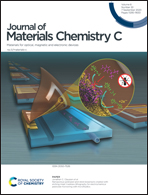Selective sensing of aliphatic biogenic polyamines by a zwitterionic Cd-MOF based on bisimidazole tetracarboxylic acid linker†
Abstract
A cadmium metal–organic framework, i.e., Cd-BBI, with ca. 43% solvent-accessible volume, was accessed starting from a rationally-designed tetraacid linker based on bisimidazole featuring concave shapes as the core scaffold. The fluorescent MOF is built up of 4-connecting anionic SBUs, which render the highly basic imidazole nitrogens protonated and the framework charge neutral with the linker essentially turning zwitterionic. The MOF is shown to serve as an efficient sensory material for detection of hazardous biogenic polyamines by ‘turn-off’ fluorescence quenching with rates (kqs) beyond the diffusional limit. The mechanism involves deprotonation of imidazolium cations that make up the walls of the channels by biogenic amines, which get protonated and remain within the channels for charge compensation. Consequently, highly selective sensing is observed for aliphatic biogenic polyamines, namely, spermine and spermidine, in preference to those containing aromatic moieties. A remarkably low detection limit of 56 ppb observed for spermine is attributed to static quenching, which is corroborated by time-resolved experiments. To the best of our knowledge, the results constitute first of their kind for selective sensing of aliphatic amines in general and biogenic amines in particular by MOFs.



 Please wait while we load your content...
Please wait while we load your content...